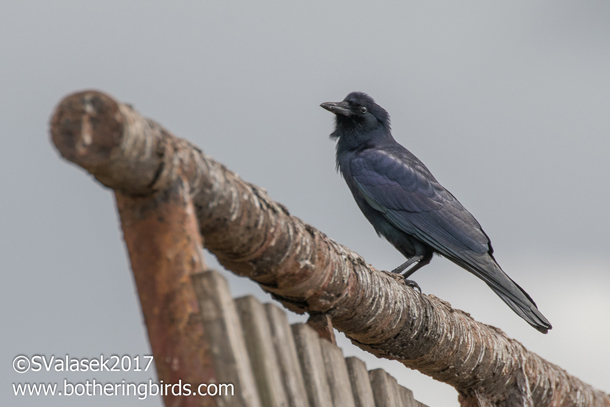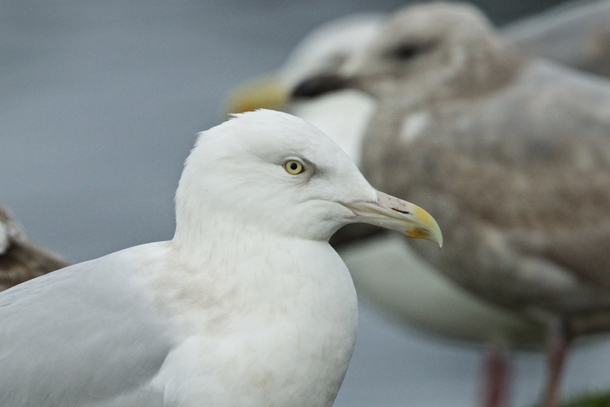BirdNote®: Unlikely Places to Go Birding
Air Date: Week of May 17, 2019

The Tamaulipas Crow is a species that is endemic to Mexico. But you can spot them in the southernmost corner of Southeast Texas, as well. (Photo: Steve Valasek)
Traditional birding often lures birdwatchers deep into some wilderness, along the banks of a running river, or at the edge of an expansive meadow. But sometimes it’s the places we least expect that provide birders with that diamond in the rough. BirdNote®’s Mary McCann tells us more about the different and unlikely places that can be a birder’s goldmine.
Transcript
[BIRDNOTE® THEME]
CURWOOD: Central Park in New York City is a hotspot for birders thanks to its patch of green amid a concrete jungle, and some 280 species of birds have been spotted in the park since it was completed in 1876. And as BirdNote®’s Mary McCann reports there are plenty of other surprising places to find a wide variety of birds.
BirdNote®: “Unlikely Places to Go Birding”
MCCANN: Location! Location! Location!
Location is just as important in birding as in real estate.
But unlike real estate, where the prime location has a panoramic view or great ambience, birding is often best in the most unlikely places.
For instance, sewage treatment plants are great places to look for birds. Watch for gulls, ducks, and the ever-vigilant raptors keeping watch, nearby.
[Cries of Glaucous-winged Gulls]

The Glaucous-winged Gull has been known to hybridize with the Western Gull. (Photo: Gregg Thompson)
Another place might be your local landfill or dump.
[Garbage truck sounds]
From Alaska to southern Texas, dumps are often great places to find good birds. The Juneau, Alaska landfill is famous for its “gathering of gulls,” and you used to be able to find lots of ravens, too.
[Gronk-gronk of Common Raven]
And at the southern tip of the country, the Brownsville, Texas dump was, for years, the only place in the US you could find a Tamaulipas Crow.
[Caws of Tamaulipas/Mexican Crows]
For a more sedate birding adventure, visit a cemetery.
[Soft twittering of a House Finch]
Especially in rural areas and in the Midwest, cemeteries are often repositories of native plants, remnants of the native habitats of the 19th century. They’re magnets for migratory birds, which find food—and cover—in those green oases. They’re quiet, too.
Just remember: birds are where you find ‘em.
[Soft twittering of a House Finch]
###
Written by Ellen Blackstone
Bird audio provided by The Macaulay Library at the Cornell Lab of Ornithology, Ithaca, New York. Glaucous-winged Gulls recorded by A.A. Allen. Common Raven calls recorded by R.S. Little. Tamaulipas Crow recorded by L. Irby Davis. Song of the House Finch recorded by G.A. Keller.
Producer: John Kessler
Executive Producer: Chris Peterson
© 2014 Tune In to Nature.org
April 2017/2019
Narrator: Mary McCann
ID# 042407unlikelyKPLU birding-08b-2009-04-13-MM-
https://www.birdnote.org/show/unlikely-places-go-birding
CURWOOD: For photos, flock on over to our website LOE.org.
Links
Find out more about this story on the BirdNote website
Living on Earth wants to hear from you!
Living on Earth
62 Calef Highway, Suite 212
Lee, NH 03861
Telephone: 617-287-4121
E-mail: comments@loe.org
Newsletter [Click here]
Donate to Living on Earth!
Living on Earth is an independent media program and relies entirely on contributions from listeners and institutions supporting public service. Please donate now to preserve an independent environmental voice.
NewsletterLiving on Earth offers a weekly delivery of the show's rundown to your mailbox. Sign up for our newsletter today!
 Sailors For The Sea: Be the change you want to sea.
Sailors For The Sea: Be the change you want to sea.
 The Grantham Foundation for the Protection of the Environment: Committed to protecting and improving the health of the global environment.
The Grantham Foundation for the Protection of the Environment: Committed to protecting and improving the health of the global environment.
 Contribute to Living on Earth and receive, as our gift to you, an archival print of one of Mark Seth Lender's extraordinary wildlife photographs. Follow the link to see Mark's current collection of photographs.
Contribute to Living on Earth and receive, as our gift to you, an archival print of one of Mark Seth Lender's extraordinary wildlife photographs. Follow the link to see Mark's current collection of photographs.
 Buy a signed copy of Mark Seth Lender's book Smeagull the Seagull & support Living on Earth
Buy a signed copy of Mark Seth Lender's book Smeagull the Seagull & support Living on Earth

